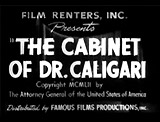
|
The Cabinet of Dr. Caligari
(1920, Ger.)
In Robert Wiene's classic and influential silent film
- with expressionist cinematography and distorted,
jagged, angular sets; for its time, this German expressionistic,
surrealistic fantasy/horror film was truly scary; it was also a landmark
film that introduced many standard horror
film conventions (some consider it the first true horror film), and one
of the earliest examples of the 'twist ending'.
The shadowy, disturbing, distorted, and dream-nightmarish
quality of the macabre and stylistic 'Caligari,' with curving alleyways,
lopsided doors, cramped rooms, overhanging buildings, and skewed
cityscapes, was brought to Hollywood in the 1920s, and later influenced
the classic period of horror films in the 1930s, and also film-noirs.
- the tale (the film's entire story) was told in flashback
by Francis (Friedrich Feher) - it was a tale of the strange sufferings
and horrible events that he had experienced
- he told about a ghost-like,
mad, and sinister hypnotist-therapist in a local carnival named Dr.
Caligari (Werner Krauss); Caligari was a fortune-teller who promoted
his "spectacle" attraction at the fair with a life-sized poster
- he performed
a crowd-pleasing show with his pale-skinned, lanky, black leotard-wearing
sleeping somnambulist named Cesare (Conrad Veidt); the main attraction
for the group of fairgoers was to awaken Cesare from a state of
sleep in a box-shaped coffin or cabinet, to prophetically
tell fortunes to audience members
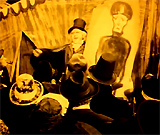
At Fair, Caligari Advertising Cesare With a Life-Sized
Poster
|
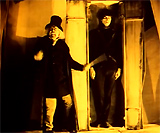
With Cesare - Dr. Caligari's Sleeping Somnambulist
in Coffin-Cabinet
|
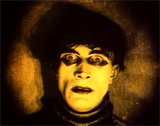
Cesare's Eyes Opening From Sleep
|
- Caligari also manipulated
Cesare to conduct his evil desires, as a haunted murderer; the shadowy figure stabbed to death Francis' friend
Alan (Hans Heinrich von Twardowski)
- in one of the more shocking
sequences, the so-called "abduction scene," Francis' 'fiancee' Jane Olsen (Lil Dagover)
was sleeping, when she was approached by the somnambulist with a long
sharp knife who was threatening to stab her. Instead, he reached out
to touch her and she was awakened. He grabbed her and dragged her from
her bed to abduct her; a chase ensued by a mob across rooftops and
down alleyways
- the film's major plot twist was that the story,
the entire film (a framed story with a flashback) was made up from
the mad ramblings and delusional nightmares of Francis, the mentally-ill,
psychotic patient who was the narrator/story-teller of the film
while he was seated in the asylum courtyard; the last scene was
of Francis becoming crazed when he saw the asylum director Dr.
Caligari - whom he insisted was the mad and sinister "Caligari" of his story. Francis
thought that Dr. Caligari was the insane director of a mental institution,
and that he was obsessed with imitating a 18th century mystic (of
the same name) who sent out his somnambulist Cesare to commit murder;
however Dr. Caligari was not a menacing figure, but Francis' benevolent,
respected asylum doctor.
|
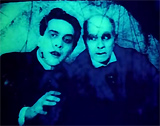
Francis (Friedrich Feher) Telling His Tale, Seated in
Courtyard
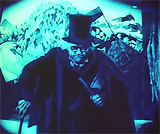
Dr. Caligari (Werner Krauss)
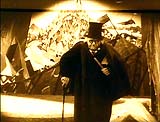
Dr. Caligari
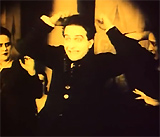 Twist Ending -- Francis Was The Insane One
Twist Ending -- Francis Was The Insane One
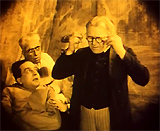
Dr. Caligari - The Respected Asylum Director with His
Patient Francis
|





 Twist Ending -- Francis Was The Insane One
Twist Ending -- Francis Was The Insane One